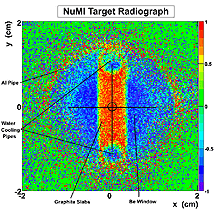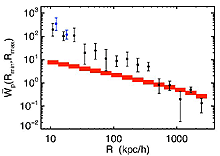
Wednesday, August 3
10:30-12:30 a.m. Fermilab Preparation for ILC Snowmass Workshop - 1 West
Speakers: H. Edwards, S. Mishra, P. Piot, N. Mokhov,
R. Kephart, V. Kuchler, J. Jackson - Fermilab
Title: Preparation for ILC Snowmass Workshop
3:30 p.m. Director's Coffee Break -
2nd Flr X-Over
4:00 p.m. Fermilab Colloquium -
1 West
Speaker: G. Barber, American Civil Liberties Union
Title: The USA Patriot Act Controversy
Thursday, August 4
2:30 p.m. Theoretical Physics Seminar -
Curia II
Speaker: H. Nunokawa, Pontifícia Univ. Católica do Rio de Janeiro
Title: Establishing Neutrino Mass Hierarchy and CP Violation by Superbeam with Twin Megaton Detectors
3:30 p.m. Director's Coffee Break -
2nd Flr X-Over
Note: There will be no accelerator physics and technology seminar today
|



Wednesday, August 3
Italian Wedding Soup with Meatballs
Diner Style Patty Melt $4.85
Chicken á la Mer $3.75
Beef and Broccoli $3.75
Greek Chicken Panini with Feta Cheese $4.75
Sicilian Style Pizza $3.00
Grilled Chicken Bowtie in a Tomato Cream Sauce $4.85
The Wilson Hall Cafe now accepts Visa, Master Card, Discover and American Express at Cash Register #1.
Wilson Hall Cafe Menu
|

Wednesday, August 3
Lunch
Tri-Colored Tortellini Salad
Lemon Cheesecake w/Blueberry Sauce
Thursday, August 4
Dinner
Smoked Salmon Plate
Veal Picatta
Spinach Fetuccini w/Tomatoes & Cream
Chocolate Fondue w/Fruit
Chez Leon Menu
Call x4512 to make your reservation.
|

|
 |
MIPP Measurements Aid MINOS Neutrino Research
|

|
|
MIPP uses a NuMI target to make precise measurements of hadron production, helping MINOS predict neutrino flux in their near and far detectors. (Click on image for larger version.) |
|
|
The Main Injector Particle Production (MIPP) Experiment, located near the
Meson Lab in the Fixed-target Area, is close to achieving its goal of
recording 2 million proton interactions on a Neutrinos at the Main Injector
(NuMI) target. The data, which will be fully analyzed in a few months, will
help members of the Main Injector Neutrino Oscillation Search (MINOS)
calculate the flux of neutrinos passing through their near and far
detectors.
Although understanding particle production is an essential part of any Fermilab experiment, precise measurements of particle production cross sections have never been made. With its full particle acceptance rate and several different kinds of targets and detectors, "MIPP hopes to acquire high quality data of a caliber not yet achieved," said MIPP spokesperson Rajendran Raja.
Currently, the absence of precise data about particle production is hindering MINOS' efforts to predict neutrino fluxes in their near and far detectors. MIPP is working to supply information about exactly how many pions and kaons are produced in a collision between the proton beam and the carbon NuMI target. Using that data, MINOS scientists will be able to predict the spectrum of neutrino interactions they should observe in their near and far detectors, assuming no neutrino oscillations. "The more precise data will enable them to ascribe deviations from the predictions to neutrino oscillations with greater confidence," Raja explained.
Ultimately, MINOS and MIPP hope to analyze 10 million proton interactions with the NuMI target. MIPP, which was approved in 2001 with funding from DOE and Lawrence Livermore Laboratory, hopes to soon receive support for an upgrade that will make the experiment 100 times faster. "Approval of the upgrade will enable MIPP to collect much greater statistics in a large number of reactions much faster including 10 million events on the MINOS target," Raja said.
—Elizabeth Wade
|

|
|
The NUMI target cross section as seen by the beam. The red areas (graphite) represent areas of high interaction probability and the blue areas represent low interaction probability. The cross marks the spot where the MIPP proton beam is incident on the NUMI target. (Click on image for larger version.) |
|

From The Beacon News, August 2, 2005
Mining the universe
By Nick Reiher
SOUDAN, MINN. — Anglers of all shapes and sizes throw their lines into the well-stocked lakes, ponds and streams plunked in among the thousands of tall, green spruces guarding the Superior National Forest in northeastern Minnesota.
But a group of scientists from throughout the world is fishing for tiny particles even more plentiful than the walleye here. Elements these anglers hope will yield clues to the very beginning, as well as the current content, of our universe.
This fishing hole is truly a hidden treasure: part of an abandoned iron ore mine in Soudan, about 10 miles west of the increasingly popular Boundary Waters recreational town of Ely, Minn. One of the nation's richest iron ore mines, in fact, from 1882 to 1962, and now a popular tourist attraction.
The equipment these scientists are using is a 6,000-ton sensor set up a half mile underground in Soudan Mine State Park. The lure? Catching newly formed neutrinos that began their 400-mile journey a few milliseconds earlier as protons shot out of the accelerator at Fermilab in Batavia.
Read More
|
|
 |

SDSS Researchers Find Many, Many Quasar Pairs
|

|
|
The measurement of the small-scale quasar correlation function by Hennawi et al. (black and blue points) strongly exceeds the extrapolation of the large-scale clustering to small scales (red squares). (Click on image for larger version.) |
|
When gas falls into a black hole, the gravitational energy that is liberated creates a powerful source of optical and X-ray emission. This process is very similar for stellar-mass black holes in the Milky Way, which we observe in X-ray binaries, and for supermassive black holes of a million to a billion solar masses, which we observe as quasars in distant galaxies.

Joseph Hennawi |
Astronomers now believe that there is such a supermassive black hole at the heart of every galaxy, and that the growth of the black hole is related to the growth of the galaxy itself, and hence to the way in which galaxies and cluster of galaxies form from the nearly smooth distribution of gas left over after the big bang. However, the details of this relation are still unclear. By mapping the distribution of galaxies and quasars, the Sloan Digital Sky Survey is shedding light on this issue. A group of SDSS researchers led by former Princeton graduate student Joseph Hennawi (now a Hubble fellow at the University of California, Berkeley) has analyzed the distribution of quasars on small scales (cosmically speaking) and found surprisingly many binary quasars (astro-ph/0504535, submitted to AJ).
The SDSS redshift (i.e., distance) surveys of galaxies and quasars were designed explicitly to study their spatial distribution. However, for technical reasons, the SDSS cannot obtain redshifts of most quasars that are close to each other. Therefore Hennawi and colleagues conducted an extensive followup program to find new quasars that are very close to other quasars, making use of the SDSS and the Anglo-Australian 2dF Quasar Redshift Survey and of a much larger sample of photometrically defined quasar candidates from the SDSS, providing an initial list of a few hundred thousand objects. After careful color selection of binary candidates, the Keck and Apache Point Observatories were used to confirm the quasar pair hypothesis. In this way, they found 218 new quasar pairs, of which 26 are within 150,000 light years of each other - doubling the known number of such objects. After applying statistical corrections, Hennawi and colleagues obtained the small-scale quasar correlation function and found that the clustering amplitude was much stronger than expected from an extrapolation of the large-scale clustering to the small scales observed here. A follow-up program is now under way to investigate whether this in fact means that quasars are triggered by interactions between galaxies.
Result of the Week Archive
|

Users' Executive Committee Elections
The election to replace half of the members of the Users' Executive Committee is well underway. Thanks to those of you have already voted. If you have still not voted, please cast your ballot. Voting will close at midnight on Thursday, August 4th, and the results will be posted early next week.
Network Outage
A 30 minute network outage, scheduled for Thursday, August 4th at 6:30 am, will disrupt email service. Both incoming and outgoing email, as well as access to webmail will be interrupted by this outage.
International Folk Dancing
International Folk Dancing will meet Thursday, August 4, in Ramsey Auditorium in Wilson Hall. Dancing begins at 7:30 p.m. with teaching earlier in the evening and request dancing later on. Newcomers are welcome and you do not need to come with a partner. Dancing will continue in the Auditorium through the summer. Info at 630-584-0825 or 630-840-8194 or folkdance@fnal.gov.
Recreation Sales Resume
On a temporary basis, the Recreation Office will resume selling AMC tickets, Renaissance Faire tickets, Wisconsin Dells coupon will be available in the Recreation Office, beginning August 3, with the following stipulations:
- Purchases may be done Tuesday through Thursday ONLY
- Cash or Check accepted. No credit card purchases
- A no refund policy will be put into effect
Canoe Rentals Resume
Canoe rentals will resume in the Recreation Office. Rentals must be paid by check or cash, no credit cards.
Upcoming Activities
|
|




